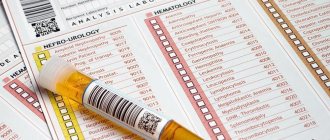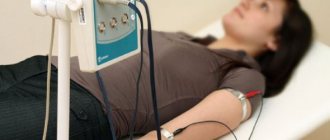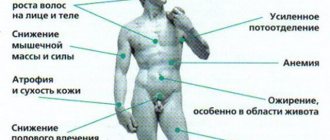Lactate dehydrogenase or LDH is a zinc-containing enzyme found inside cells.
Its main functions are the conversion of lactic acid into pyruvic acid (pyruvate), and its important function is to prevent the reverse reaction of the previous process.
The concentration of this enzyme is observed in all tissue formations of the human body. The tissues of the liver, heart, skeletal muscles, kidneys, as well as red blood cells have the highest concentrations.
In the latter, it is presented in the form of five isoenzymes, which are numbered from one to five, respectively.
In a healthy state of the body, the LDH value does not accumulate. This enzyme is excreted from the body in the same amount as it is formed. The value of lactate dehydrogenase does not indicate the development of pathological conditions in the body. It determines the consequences of the disease - deformation of cells and tissues in the human body.
Basic concepts and functions of LDH
LDH (lactate dehydrogenase) is an oxidoreductase enzyme that accelerates the reaction of lactic acid formation during glycolysis (glucose oxidation). Like most catalysts, lactate dehydrogenase does not accumulate in cells, but is excreted from the body in an amount equivalent to that formed.
The highest concentration of the enzyme is observed in the parenchyma of the liver and kidneys, in the tissues of the muscular system and heart. Each localization area has its own isoenzyme (a type of LDH). Lactate dehydrogenase is found in small amounts in red blood cells (erythrocytes).
An increase in the level of the enzyme in the blood occurs during the destruction of LDH-containing cells. By assessing the type of elevated isoenzyme during biochemistry, the location of the damage is determined, that is, the organ whose cells have undergone destruction. The enzyme isoforms are numbered 1 to 5, depending on their location:
| Isoenzyme number | Location | Percentage concentration in blood |
| № 1 | muscle layer of the heart (myocardium), brain tissue | 17–27 |
| № 2 | blood cells (platelet and erythrocyte), renal parenchyma | 27–37 |
| № 3 | lungs, spleen, thyroid gland, adrenal glands, lymphocytes, pancreas | 18–25 |
| № 4 | granular leukocytes, placenta, spleen, adrenal glands, male reproductive cells, lungs, thyroid and pancreas | 3–8 |
| № 5 | hepatocytes (liver cells), bone tissue | up to 5 |
Increased activity of one or another type of lactate dehydrogenase is a marker of the destructive transformation of the tissue of the organs in which it is contained. In a standard biochemical analysis, the form usually indicates the total LDH indicator.
If necessary, an extended study is carried out, assessing each individual isoform of the enzyme (Sevel-Tovarek test, urea inactivation and thermal inhibition methods). In the blood of a healthy person, LDH is static and has certain reference values.
Important! The changed concentration of lactate dehydrogenase does not diagnose a specific disease. The obtained values are compared with other indicators of biochemical analysis. Unsatisfactory results are grounds for additional examination of a particular system or organ.
Why do LDH levels decrease?
If the level of this enzyme is lowered, then the cause is easier to determine, since a small range of factors contribute to this. Registration of low rates is observed in very rare cases. Doctors do not consider a decrease in LDH levels to be an indication of a pathological condition.
In most cases, the indicator is low when consuming vitamin C, or increased glucose oxidation. In the rarest cases, LDH is reduced in hereditary diseases, but such cases are rare.
Indications for research
Blood biochemistry is prescribed:
- according to symptomatic complaints of the patient;
- during a routine check (dispensary examination, screening of pregnant women, IVK, etc.);
- to control the therapy;
- in preparation for surgical interventions.
Increased attention to LDH indicators in a blood test is paid in case of a presumptive diagnosis:
- anemia (anemia);
- ischemic necrosis of part of the myocardium (infarction);
- cirrhosis, hepatitis, liver carcinoma (cancer);
- oncohematological diseases (cancer tumors of the blood and lymphoid tissue);
- blood poisoning (sepsis);
- severe intoxication accompanied by the destruction of red blood cells (hemolysis of red blood cells);
- necrotic processes, and mechanical damage to internal organs.
The biochemical composition of the blood is checked after a course of chemotherapy drugs. For differentiated diagnosis of some bacterial and viral infections, the level of LDH is determined by analyzing the cerebrospinal fluid (cerebrospinal fluid).
Prevention
In order for the LDH level to be within normal limits, it is recommended to follow preventive actions aimed at counteracting the progression of many diseases:
- Proper nutrition. A balanced diet is necessary, excluding unhealthy foods, highly fried, salty, and spicy foods. Eat more fresh vegetables and fruits, as well as lean meats and foods rich in vitamins and nutrients,
- A healthy lifestyle is an integral factor in the prevention of most diseases. It is recommended to exercise to maintain body tone, as well as to avoid excess weight and increased cholesterol deposits,
- Avoiding stress . Limit yourself as much as possible from nervous tension, stressful influences and strong emotional stress. All of them have a detrimental effect on overall health,
- Take medications regularly if prescribed by your doctor. Failure to comply with the course of therapy can lead to tissue death in the body and death,
- Stay hydrated. Drink at least one and a half liters of clean water per day,
- Avoid drinking alcoholic beverages and cigarettes,
- Once a year, be examined by a doctor, take a blood test and fully examine your body. This will help detect diseases at an early stage of development, which will greatly facilitate the course of therapy and the possibility of complications.
This list of actions is aimed at preventing a large number of diseases and will help minimize the chance of damage to the body.
Blood analysis
To obtain objective results, blood should be donated on an empty stomach. The fasting regime should be from 8 to 10 hours. On the eve of the analysis it is recommended:
- limit sports (other physical) activities;
- eliminate fatty foods (sausages, mayonnaise sauces, pork, lamb, etc.) and fried foods from the diet;
- exclude alcohol-containing drinks;
- give up coffee;
- stop taking anticoagulants, hormone-containing drugs, ascorbic acid.
Venous blood is collected in the morning in a laboratory setting
Blood for analysis is taken from a vein. Decoding is carried out by comparing the obtained indicators with reference values. The results of the study can be viewed within 24 hours. If an emergency laboratory assessment of LDH levels is necessary (acute conditions), the blood is examined without prior preparation.
Some nuances
To study LDH in the blood, 1 ml of serum is sufficient, which is obtained from blood donated, as for any other biochemical test, in the morning on an empty stomach (however, if there is a question about diagnosing acute MI, then these rules, of course, are neglected).
In a laboratory study of LDH, hemolysis leads to distortion of the analysis results (overestimates them). And when exposed to heparin and oxalate, the enzyme activity in the serum, on the contrary, will be reduced compared to the real blood LDH values. To prevent this from happening, you should start working with the material as early as possible, first of all separating the clot with formed elements from the serum.
Standard values
The normal level of LDH in the blood of children and adolescents is determined by age. In adults (after 17 years), normative values are graded according to the patient’s gender. The standard measurement of lactate dehydrogenase in laboratory microscopy is U/L.
Reference values for enzyme concentrations for children and adolescents (in units/l)
| Newborn | Baby up to one year old | Up to 3 years | Up to 6 years old | Up to 12 years | Up to 17 years old |
| 2000 | < 451 | < 344 | < 314 | < 332 | < 280 |
In women, the level of LDH in the blood is lower than in men, which is due to less intense physical activity. Women's standard values range from 135 to 214 U/l, men's - from 135 to 225 U/l. A slight excess of reference values is observed in professional athletes and pregnant women.
Deviation of enzyme activity values in the direction of increasing or decreasing indicators is the basis for advanced diagnostics (laboratory tests and hardware examination of the patient).
What are normal LDH levels?
Normal levels for LDH in a healthy person vary in women and men. The levels are different for adults and children, and the levels also vary depending on gender.
LDH standards are shown in the table below.
Age categoryNormal values (units/l)
| Newborns | 150 – 780 |
| From 1 month to six months | 160 – 440 |
| From 7 months to a year of life | 145 – 365 |
| From 1 year to 2 years | 86 – 305 |
| From 3 to 16 years | 114 – 300 |
| Women | 125 — 211 |
| Men | 125 – 226 |
In newborn babies, blood lactate is always elevated. Decoding the analysis is the job of a qualified doctor, since when analyzing the results, it is necessary to take into account the age category of the child and his physical indicators.
Indicators are also calculated depending on physical activity. When a child actively engages in sports, the LDH level is increased, which is normal. And in females the indicator is lower than the norm than in males.
The definition of units of measurement and normal indicators may vary depending on the laboratory in which the study is carried out.
For an accurate deciphering, you need to clarify these factors directly at the place where the analysis is carried out.
Reasons for deviations
In most cases, an unsatisfactory result of a biochemical blood test for LDH means an increase in the concentration of the enzyme. This is explained by the fact that when there is a destructive violation of the integrity of the cellular structure of an organ, a significant part of lactate dehydrogenase enters the bloodstream. An extremely reduced level of the enzyme or its complete absence is observed in the decompensated stage of liver cancer and cirrhosis.
Increased rate
Elevated LDH is one of the main clinical diagnostic indicators of myocardial infarction. The enzyme reaches its maximum activity in the first 24 hours from the onset of a heart attack and remains in increased concentration for 1–2 weeks. In this case, the duration and degree of activity reflect the scale of necrotic damage to the heart muscle (values can increase tens of times).
The total LDH level is increased due to a sharp increase in the concentration of isoenzyme No. 1, localized in the myocardium. To obtain an accurate picture, the ratio of the total content of lactate dehydrogenase to the amount of isoenzyme No. 1, otherwise hydroxybutyrate dehydrogenase (HBDH), is estimated. In acute cases, GBDG is always elevated, since the total amount of enzyme is reduced in relation to the high concentration of isoenzyme No. 1.
Myocardial infarction is accompanied by an increase in LDH levels
An increase in indicators accompanies any pathological processes characterized by the death of cells and tissues. In addition to necrotic damage to the heart muscle, the causes of increased LDH levels may be:
ALT and AST in blood tests
- Blockage of the lumen of the pulmonary artery by a blood clot that has budded from the main thrombus located in a large vein (pulmonary embolism).
- Malignant neoplasms of various locations (liver, kidneys, etc.), and secondary tumor foci (metastases).
- Oncohematology.
- Anemia (anemia) of various origins associated with hemolysis of red blood cells. Hemolytic anemia is associated with poisoning of the body with heavy metals or with incorrectly performed blood transfusion (blood transfusion). Addison-Birmer disease or pernicious anemia develops due to a lack of cyanocobalamin (vitamin B12) in the body.
- Liver diseases associated with the death of hepatocytes.
- Destructive and degenerative processes in muscle fibers, muscle atrophy, traumatic damage to muscle tissue.
- Inflammation of the tubular system of the renal apparatus, damage to the glomeruli (glomeruli of the kidneys), otherwise glomerulonephritis, necrosis of the kidney.
- Viral infection of the lymph nodes, pharynx, liver, spleen (mononucleosis).
- Acute inflammation of the pancreas (pancreatitis).
- Termination of functionality (death) of pancreatic cells (pancreatic necrosis).
- Death of the intestinal wall due to insufficient blood supply (intestinal infarction).
- Bone fractures.
- Pathology of the thyroid gland, in which the synthesis of hormones is reduced (hypothyroidism).
- Acute symptomatic seizure;
- Metal-alcohol psychosis (“delirium tremens”).
- Severe gestosis (pathological toxicosis in the second half of pregnancy).
- Extensive skin burns.
- Infectious-toxic pneumonia (Pneumocystis pneumonia).
- Early separation of the provisional organ from the walls of the uterus (premature placental abruption).
- Violation of coronary blood flow (coronary insufficiency);
- Heart disease in the decompensated stage.
- Necrotic lesion of a part of a living organism (gangrene).
Chemotherapy causes a natural increase in LDH. The aggressive treatment method kills not only pathological cells, but also destroys some healthy ones.
Reduced rate
The condition of low lactate dehydrogenase levels is much less common. First of all, incorrect therapy with ascorbic acid preparations, anticonvulsant and antitumor medications, antibiotics, and hormonal medications is assumed.
The reasons for the decrease in enzyme levels may be a violation of pH (acidity) due to the presence of oxalic acid salts (oxalates), or genetic abnormalities. If the values drop, the patient’s medications are discontinued (except for vital ones).
Important! LDH levels in the blood can change not only due to cell destruction, but also for non-pathological reasons.
Non-pathological changes in indicators
Factors that distort the results include:
- non-compliance with the rules of preparation for blood sampling for LDH;
- intense sports training;
- physical or psycho-emotional overload on the eve of analysis;
- thrombocytosis - an abnormal increase in blood platelets (platelets) in the blood;
- acute and chronic skin diseases;
- extrarenal blood purification by hemodialysis;
- perinatal period in women.
The medical reason for unreliable results may be incorrect blood sampling and examination of biomaterial
LDH indicator and myocardial tissue death
The study of this indicator has important diagnostic value for structural disorders of the myocardium. This analysis is one of the main studies of enzymes that determine the death of heart muscle tissue in the first 24 hours of heart attack progression.
The LDH level will be increased after the first ten hours from the onset of pain and the progression of necrotic changes in the heart muscle; first of all, the indicator of the first fraction (LDH-1) increases, and the second fraction indirectly increases.
In addition to the increase in the overall indicator of lactate dehydrogenase, a special role in the death of cardiac tissue belongs to the first fraction, which is also called hydroxybutyrate dehydrogenase, and the ratio between the first and second fractions.
Hydroxybutyrate dehydrogenase
With necrotic changes in the myocardium, the total LDH index will be reduced in relation to LDH-1. With such processes, the overall level will tend to a smaller number, while the first fraction will only increase.
Changes in the first fraction and total indicators, similar to cardiac tissue necrosis, may also indicate the following diseases:
- Death of tissue in the kidneys
- Tumor formations in the female and male reproductive systems,
- Pathological conditions that are accompanied by severe cell destruction,
- Megaloblastic anemia. With this disease, the level of the first fraction is several times higher than the second,
- Various hemolytic anemias.
Diagnosis of diseases is confirmed with the help of additional hardware tests prescribed by a doctor based on the inherent symptoms and laboratory test results.
Additionally
To reduce the level of the enzyme, it is first necessary to diagnose the underlying disease that caused the change in LDH concentration. Auxiliary diagnostics include:
- laboratory blood test to determine the content of enzymes:
- hepatic and cardiac - ALT and AST (alanine aminotransferase and aspartate aminotransferase);
- muscle - CPK (creatine phosphokinase);
- ALP (alkaline phosphatase).
- blood test for the globular protein troponin and the oxygen-binding protein myoglobin.
- advanced analysis to determine the concentration of all isoenzymes.
With a comparative assessment of all indicators, a hardware examination of internal organs is prescribed (ultrasound, MRI, CT and other procedures, depending on the expected location of the disorders).
LDH norm in the body and interpretation of the analysis
When testing blood, the norm is usually indicated in units/l, which means one per liter. The interpretation of the analysis takes into account the age and gender of the patient. A relatively small amount of the enzyme is found in the blood of a healthy adult. In a child under two years of age, the norm is considered to be within 430 units/l.
| The first days of life LDH is normal | at level 150-785 |
| first six months | 160-437 |
| from 7 to 12 months | 145-365 |
| from 1 year to two years | 86-305 |
| from 3 to 16 years | 100-290 units/l |
| in children under 12 years of age | not higher than 295 units/l |
| in men | 120-214 units/l |
| LDH levels are higher in women | 135-240 |
An increase in lactate dehydrogenase occurs during pregnancy, in newborns, and in professional athletes.
Based on the identified marker, it is impossible to determine which cells were damaged. Therefore, when deciphering LDH, it is necessary to know what its isoenzymes are. Some laboratories conduct additional tests that determine several forms of the substance, starting with the most mobile:
the first indicates a problem of the heart, kidneys and red blood cells, the second is found mainly in cardiomyocytes and red blood cells, the third is found in lung tissue, endocrine glands and adrenal glands, the fourth is an enzyme in white blood cells, liver, placenta and male testicles and muscle tissue, the fifth is found in all organs containing LDH-4, as well as skeletal muscles.
Deciphering biochemistry for increased LDH in the blood is now considered less informative.
High values of all isoenzymes determine the pathology of several organs. Myocardial infarction with congestive heart failure causes lung damage and liver congestion. In cancer and autoimmune diseases such as lupus, lactate dehydrogenase is generally elevated.
The dynamics of the first isoenzyme are more sensitive and specific than the increase in LDH in general. Usually the level of the second isoenzyme is higher than the first. If the concentration of LDH-1 increases relative to LDH-2, a heart attack is diagnosed. Typically, the LDH level in the blood is exceeded 12-24 hours after damage to heart tissue and for two days in 80% of cases.
the LDH/GBDG figure is reduced (less than 1.30), the LDH-1/LDG-2 ratio approaches 1 and sometimes exceeds this value.
On the first day, myocardial infarction is diagnosed by the creatine kinase indicator, and a day later - by the enzymatic study of LDH. The activity of the substance is directly related to the area of damage to the heart muscle.
Other serious diseases are reflected in the ratio of isoenzymes and coefficients:
hemolytic anemia is characterized by a low LDH/GBDG figure - up to 1.3 and lower, with megaloblastic anemia LDH-1 significantly exceeds LDH-2, the overall level increases during acute necrotic processes and cell death, such as damage to the kidney parenchyma, tumors in the gonads ( ovaries and testes) are accompanied by an isolated increase in LDH-1.
Most often, LDH is elevated due to the destruction of tissue of the liver and kidney parenchyma, and the death of platelets and red blood cells.
LDH in a blood test is considered in relation to other indicators:
With anemia, red blood cells are destroyed, which releases large amounts of LDH into the blood. The disease is diagnosed against the background of low hemoglobin. Weakness, pallor, shortness of breath may be indications for examination. Blood cancer is associated with the production of abnormal blood cells, which is reflected in the levels of many indicators: LDH, aspartate aminotransferase, bilirubin, urea. At the same time, there is a decrease in the level of glucose and the blood clotting factor fibrinogen. A biochemical blood test allows one to suspect pathology and refer the patient to identify tumor markers. Along with the LDH level in the blood, which indicates the death of pancreatic cells, bilirubin and glucose will increase. The primary indicator is the level of the pancreatic enzyme amylase.
Results
Lactate dehydrogenase is an enzyme that catalyzes the oxidation of glucose and the formation of lactic acid. The main amount of LDH is concentrated in the kidney, liver, cardiac tissues and muscle fibers. A specific isoenzyme (a type of LDH) is responsible for each organ.
Standard values for blood levels in adults
| Women | Men |
| from 135 to 214 U/l | from 135 to 225 U/l |
Children's indicators are graded by age category. If a biochemical analysis determines increased activity of lactate dehydrogenase in the blood, it means that the integrity of the parenchyma of the liver, kidneys, and myocardium (heart muscle) is compromised. In case of destructive damage to the listed organs, the enzyme is released into the systemic bloodstream through the affected areas.
High rates are clinical signs of heart attack, cirrhosis, cancerous tumors, pancreatic necrosis, pulmonary thromboembolism, renal diseases and other pathologies associated with tissue destruction and death of cellular structures. Based on the results of the study, a specific disease is not diagnosed. A shift in indicators is the basis for an extensive examination of the patient.
The importance of the enzyme in the body
Interest in what LDH is in a biochemical blood test is associated primarily with myocardial infarction.
Previously, this test was used to diagnose and monitor damage to cardiac tissue, but now the troponin test is considered more accurate and informative. Lactate dehydrogenase (LDH) is not a specific indicator of cardiac cell damage and is no longer used in patients with suspected acute coronary syndrome.
Typically, the transcript of a biochemical blood test contains this indicator. Lactate dehydrogenase in the blood is an important enzyme involved in the reactions:
glucose oxidation, lactic acid production.
The peculiarity of the enzyme is that it does not accumulate in cells, but is completely broken down and excreted. LDH is essential for converting glucose into energy for the functioning of all cells in the body. The reaction is mediated by oxygen, which helps break down glucose into water, carbon dioxide and energy.
Without oxygen, energy production decreases by 20 times and lactic acid accumulates. The enzyme LDH is necessary for its oxidation and return to glucose metabolism. Unlike healthy cells, cancerous tumors feed without oxygen.
Possible complications
Incorrect or untimely therapy for high levels of lactate dehydrogenesis will lead to progression of the disease, against the background of which the parameters have changed. Complications can even lead to death.
Progressive pathological processes enter a severe stage or chronic form. The risk of heart attack and stroke increases, and the likelihood of liver dysfunction is high. Without timely therapy, the affected cells and tissues will begin to die or be destroyed.
Biochemical analysis of Ldh in the blood is the primary examination method, with which the doctor makes a preliminary diagnosis. Guided by the results obtained, the specialist refers the patient for a detailed diagnosis in order to understand exactly where the pathological focus is located and what treatment method will help eliminate the pathological processes.
Enzyme isoforms
Taking into account the physicochemical properties of lactate dehydrogenesis, in medicine the following isoforms of the enzyme are distinguished:
| Name | Place of generation |
| LDH-1 | Cardiovascular system, kidneys and blood |
| LDG-2 | Spleen and lymph nodes |
| LDG-3 | Organs of the respiratory system and pulmonary structures |
| LDG-4 | Placenta, pancreas, digestive system organs |
| LDG-5 | Skeletal muscles and liver |
If necessary and there is a significant increase in the parameters of lactate dehydrogenesis in human blood, specialists conduct thorough tests, examining the isoenzymes separately.











